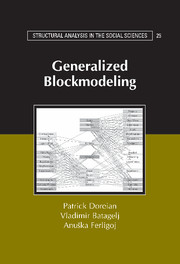Book contents
- Frontmatter
- Contents
- Preface
- 1 Social Networks and Blockmodels
- 2 Network Data Sets
- 3 Mathematical Prelude
- 4 Relations and Graphs for Network Analysis
- 5 Clustering Approaches
- 6 Optimizational Approach to Conventional Blockmodeling
- 7 Foundations for Generalized Blockmodeling
- 8 Blockmodeling Two-Mode Network Data
- 9 Semirings and Lattices
- 10 Balance Theory and Blockmodeling Signed Networks
- 11 Symmetric–Acyclic Blockmodels
- 12 Extending Generalized Blockmodeling
- Bibliography
- Author Index
- Subject Index
- Titles in the series
11 - Symmetric–Acyclic Blockmodels
Published online by Cambridge University Press: 13 January 2010
- Frontmatter
- Contents
- Preface
- 1 Social Networks and Blockmodels
- 2 Network Data Sets
- 3 Mathematical Prelude
- 4 Relations and Graphs for Network Analysis
- 5 Clustering Approaches
- 6 Optimizational Approach to Conventional Blockmodeling
- 7 Foundations for Generalized Blockmodeling
- 8 Blockmodeling Two-Mode Network Data
- 9 Semirings and Lattices
- 10 Balance Theory and Blockmodeling Signed Networks
- 11 Symmetric–Acyclic Blockmodels
- 12 Extending Generalized Blockmodeling
- Bibliography
- Author Index
- Subject Index
- Titles in the series
Summary
Here we introduce a new type of permitted diagonal block and a new type of blockmodel, respectively labeled the symmetric block and the acyclic blockmodel. The idea behind these two objects comes from a consideration of the idea of a ranked-clusters model from Davis and Leinhardt (1972), which we discussed in Chapter 1. We examine the form of these models and approach them with the perspective of specified blockmodeling. As a consequence, we do not consider the distribution of triads. Instead of considering permitted and forbidden triads, we focus on allowed and not allowed blocks. Operationally, this focuses on allowed and not allowed ties within blocks according to the type of block. The symmetric–acyclic blockmodel was introduced informally in Chapter 1 (Section 1.4.3). We note that the symmetric–acyclic blockmodel and the symmetric–acyclic decomposition are used in conjunction with each other. They share the same conceptual foundations but differ in the formal details of their execution for a given network.
BLOCKS FOR DIRECTED GRAPHS AND ACYCLIC GRAPHS
The networks considered here have directed ties so that the appropriate tools for representing these structures are directed graphs.
The model shown in Figure 1.4 is an example of an acyclic directed graph, and the ideal ranked-clusters model is acyclic. The distinction between mutual and asymmetric ties is critical, for these ties are distributed in a systematic fashion. Actors within subgroups are linked only by mutual ties, whereas asymmetric ties are directed only up. Thus, asymmetric ties within levels and down levels, as well as mutual ties between levels, are excluded. It is useful to distinguish the two important properties, and hence inconsistencies, for the ranked-clusters model.
- Type
- Chapter
- Information
- Generalized Blockmodeling , pp. 326 - 346Publisher: Cambridge University PressPrint publication year: 2004

